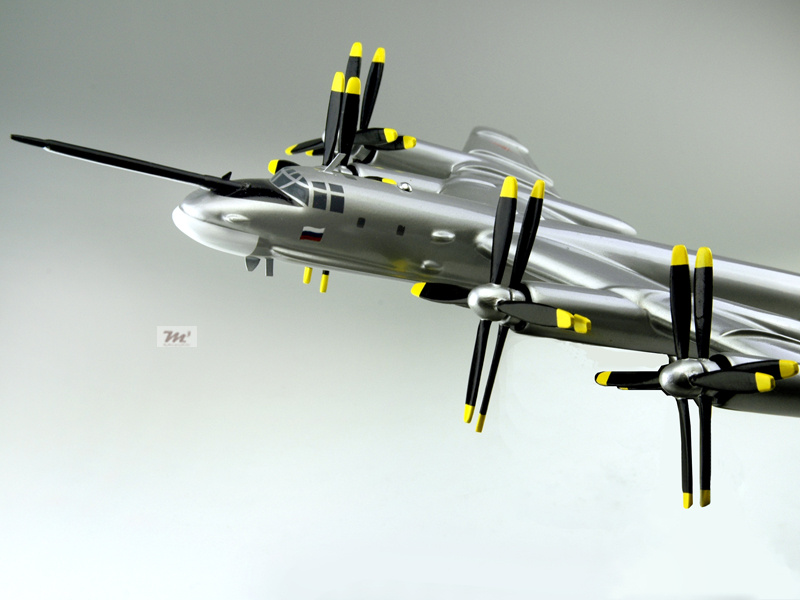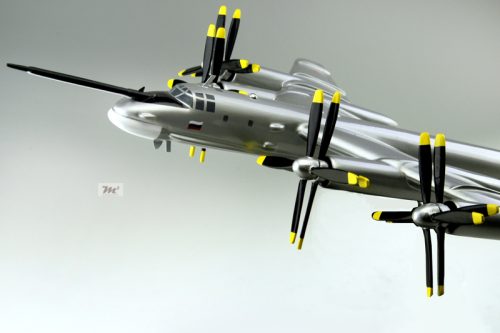Tupolev Tu-95 Bear Russian Air Force Model
Production Time 9 to 10 weeks
Shipment is by FedEx, UPS or DHL International Express Courier with a normal door-to-door delivery time worldwide of within 2-3 business days after dispatch. Due to the current volatility of world fuel prices, the amount mentioned here is our best estimate for DHL and UPS and may be subject to change at the time of shipping.

Product Statistics
Length: 16.5 Inches (41.9 Centimeters)Wingspan: 17 Inches (43.2 Centimeters)
Height: 4 Inches (10.2 Centimeters)
Scale: 1:118
$249.50
Manufacturer: Tupolev
Production Time 9 to 10 weeks
-
United States dollar ($)
-
Pound sterling (£)
-
Euro (€)
-
Australian dollar ($)
-
Canadian dollar ($)
-
Singapore dollar ($)
-
Swiss franc (CHF)
-
Japanese yen (¥)
-
Danish krone (kr.)
-
Hong Kong dollar ($)
-
Norwegian krone (kr)
-
Swedish krona (kr)
General Product Description
Our MyMahoganyModel Tupolev Tu-95 Bear Russian Air Force Model exhibits unique, unrivaled quality and detailed design to come as close as possible to the accuracy of the actual plane. It comes as standard with a robust, durable base or stand which is available in a variety of different finishes designed to match your own personal requirements including solid wood, wood with polished metal supports or adjustable wood wall mount and will be ready within about 9-10 weeks from placement of order.
The Tupolev Tu-95 Bear Russian Air Force Model is made of the finest kiln dried renewable mahogany wood (commonly known as Lauan or Meranti) which has undergone many stages of carving and meticulous and careful sanding giving the beautiful, finished museum quality masterpiece. Many collectors and model connoisseurs demonstrate their preference for genuine handmade and hand painted mahogany wood models rather than plastic or die cast (diecast) alternatives due to the overall look and totally different feel of the item - we trust you will find the same. We can however, if required produce the same model in Solid Cast Resin so just click and contact us for further information. Our craftsmen and gifted artisans ensure that our finely handcrafted model airplanes match the precise blueprint details of the original aircraft. The paint scheme, markings and parts are closely matched, reflecting the original aircraft. This stylish top-quality desktop replica model will surely enthrall anyone who receives this as a gift and for sure one of the most appropriate and desirably collectable gifts for any military aviation enthusiast and avid aircraft collector whilst also displaying a perfect resemblance to the actual real life version.
There are many types of military propeller aircraft, but the basic types are bombers, fighters, fighter bombers, spotter planes, transporters, patrol aircraft, trainers, and reconnaissance and observation aircraft. All these types of aircraft are used for different types of missions. If you're a fan of historic or present-day military aviation, our model aircraft will bring the excitement and character of these aircraft right into your own home. You can order a wood airplane model of a North American B-25 Mitchell Bomber, a B17 - Flying Fortress, or a P-51 Mustang Nervous Energy V not forgetting the Bf 109, Spitfire, FW 190, A6M Zero, P-38 and F4U. These classic, propeller airplane models are of the highest quality. Each is individually crafted by our expert craftsmen. They produce handmade scale mahogany airplane models of the finest aircraft from World War I and II to present day biplanes and triplanes.
If you require, we can also make the Tupolev Tu-95 Bear Russian Air Force Model in any other military, government or even private livery or colour scheme you require and if necessary, in a different size or scale. Just click here to contact us with a description or photographs of what you require, and we will let you have a quotation for the necessary customization by return email. We can also make bespoke scale replicas of any other private / civil commercial airliner or airliners, helicopter, glider, gliders with engines, military jet, warplane jets, biplane, triplane, tail fin, spacecraft, rocket or NASA model you require in any airline, military or civilian livery or colors. We also produce model airships, blimps, dirigibles, blimps, boats, and ship collectibles. Wall plaque or seal for military, government or private customers. Again, by clicking here to contact us just let us know exactly what you need.
The TU-95 BEAR was perhaps the most successful bomber produced by the Soviet aviation, enjoying long service in a variety of roles and configurations. It was the only bomber deployed by any country to use turbo-prop engines, which provided extraordinarily long endurance at speeds only slightly less than comparable turbojet-powered heavy bombers.
Development of the TU-95 intercontinental bomber began in the early 1950s after series production of the medium-range TU-4 started.. Initially, several designs were considered, including a modification of the TU-4 and production of a new aircraft with piston engines. Prototypes of these aircraft were developed and tested from 1949 through 1951, it was concluded that bombers with piston engines could not provide adequate performance for the intercontinental attack mission. In March 1951 development of the T-4 intercontinental jet bomber began. However, KB Tupolev did not support the development of a bomber with turbojet engines, believing that the proposed AM-3 jet engines would not provide for the required range of more than 10,000 km. As an alternative, KB Tupolev proposed an aircraft with four turbo-prop engines that would provide a range of more than 13,000 km and speeds of more than 800 km/h at altitudes of 10,000 meters. The aircraft-design was designated as 95.
The design of the wings drew heavily on the experience gathered by Tupolev and the Central Aerohydrodynamic Institute (TSAGI) during the development of the swept wing TU-16. The wings of the 95 were swept back at an angle of 35 degrees, allowing the placement of a large bomb bay behind of the torsion box of the wings central unit at the aircrafts center of gravity.
The Bears wings are mid-mounted, swept-back, and tapered with blunt tips. Its engines consist of four turboprops with contrarotating propellers located on the wings. The engine nacelles extend well beyond the wings rsquo; leading edges. The fuselage of the Bear is tube-shaped with a rounded nose that tapers to the rear. It also has a stepped cockpit and a tail gun compartment. The tail of the aircraft is a fin that is swept-back and tapered with a square tip.
The greatest difficulties during the development were the engines. After studies on different engine combinations and versions, the final design of the aircraft incorporated four turbo-prop engines with a thrust of about 10,000-shp. In the late 1940s, the most powerful turbo-prop engine available was the BK-2 prototype which had significantly less thrust (4800-shp). In the early 1950s OKB-276 N.A. Kuznetsov developed the TV-2 engine and the TV-2F booster engine with a thrust of 6,250-shp. while work on the TV-12 engine with sufficient thrust for the 95 aircraft continued.
After consideration of Tupolevs proposals, on 11 July 1951 the government officially approved the development of the 95 aircraft: Two versions were built, one with eight TV-2F engines coupled through the reduction gearbox in four pusher-tractor tandem pairs, and a second version with four TV-12 engines. N.I. Bazenkov became the chief designer of all subsequent TU-95 versions. When he died in 1975, N.V. Kursanov took over as chief designer, and from the end of the 1980s, D.A. Antonov became head of the program.
In 1952, the first prototype 95/1, equipped with 8 2TV-2F engines, was built at Plant Nr. 156. The reduction gearbox and the four-blade contra-rotating propellers were developed by OKB-120 headed by K.N. Zhdanov. Each pair generated a thrust of 12,000-shp. The first flight of the 95/1 airplane took place on 12 November 1952, but on 11 May 1953 during its 17th flight the plane crashed and burned due to an engine fire. The second prototype (95/2), equipped with TV-12 engines, was completed in June 1954 with a first flight on 16 February 1955. During tests, while carrying a load of 5000 kg, it reached a range of about 15,000 km, a speed of 993 km/h and a ceiling of 11,300 m. Series production of the aircraft — now designated as TU-95 — started in January 1956 at Plant Nr. 18 in Kuibyshev, while production tests were still underway.
| Weight | 6 kg |
|---|---|
| Dimensions | 16.5 × 17 × 4 in |











Reviews
There are no reviews yet.